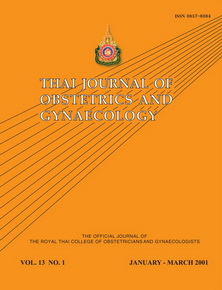Primary Epithelial Cancer and Malignant Germ Cell Tumor of the Ovary: a Review of 368 Cases
Main Article Content
Abstract
Objective To analyze the clinical characteristics, histological types, surgical findings, and
staging of primary epithelial cancer and malignant germ cell tumors of the ovary.
Design Cross-sectional study.
Setting Department of Obstetrics and Gynecology, Faculty of Medicine Siriraj Hospital, Mahidol University.
Subjects Three hundred and sixty-eight patients with primary epithelial cancer and malignant germ cell tumor of the ovary were evaluated retrospectively between January 1988 and December 1997. Information on patients’ characteristics was identified according to age, parity, menopausal status, symptomatology, tumor size, laterality, histological type, and staging.
Results The incidence of primary ovarian cancer was 23.7% of all ovarian tumors. Epithelium was the most common histological type (84.3%), and germ cell was the second most common tumor (9.1%) found in this study. Serous (36.4%) and dysgerminoma (30.6%) were the most common cell type among epithelial and germ cell tumor, respectively. The mean age of patients with germ cell tumor was significantly less than that of patients with epithelial tumor (p < 0.001). Nulliparity was found more commonly in patients with germ cell tumor than those with epithelial tumor (p < 0.001) and almost all patients with germ cell tumor were in reproductive age. The majority of patients with germ cell tumor had unilateral ovarian involvement (83.3%), while bilaterality was found more commonly in epithelial group (p < 0.01). The most common presenting symptoms of patients with epithelial tumor was abdominal distention, while palpable abdominal mass was the most common symptoms in the germ cell group. More than half of the patients in both groups had advanced stage of disease at the time of diagnosis. However, presenting symptoms and staging showed no significant difference between the two groups.
Conclusion Ovarian malignancies are not uncommon among ovarian tumors. While malignant germ cell tumor tends to occur in young women, epithelial ovarian cancer is primarily the disease of older group. It is one of the most challenging problems in gynecology, since more than half of the patients already have stage III or IV disease at the time of diagnosis.
staging of primary epithelial cancer and malignant germ cell tumors of the ovary.
Design Cross-sectional study.
Setting Department of Obstetrics and Gynecology, Faculty of Medicine Siriraj Hospital, Mahidol University.
Subjects Three hundred and sixty-eight patients with primary epithelial cancer and malignant germ cell tumor of the ovary were evaluated retrospectively between January 1988 and December 1997. Information on patients’ characteristics was identified according to age, parity, menopausal status, symptomatology, tumor size, laterality, histological type, and staging.
Results The incidence of primary ovarian cancer was 23.7% of all ovarian tumors. Epithelium was the most common histological type (84.3%), and germ cell was the second most common tumor (9.1%) found in this study. Serous (36.4%) and dysgerminoma (30.6%) were the most common cell type among epithelial and germ cell tumor, respectively. The mean age of patients with germ cell tumor was significantly less than that of patients with epithelial tumor (p < 0.001). Nulliparity was found more commonly in patients with germ cell tumor than those with epithelial tumor (p < 0.001) and almost all patients with germ cell tumor were in reproductive age. The majority of patients with germ cell tumor had unilateral ovarian involvement (83.3%), while bilaterality was found more commonly in epithelial group (p < 0.01). The most common presenting symptoms of patients with epithelial tumor was abdominal distention, while palpable abdominal mass was the most common symptoms in the germ cell group. More than half of the patients in both groups had advanced stage of disease at the time of diagnosis. However, presenting symptoms and staging showed no significant difference between the two groups.
Conclusion Ovarian malignancies are not uncommon among ovarian tumors. While malignant germ cell tumor tends to occur in young women, epithelial ovarian cancer is primarily the disease of older group. It is one of the most challenging problems in gynecology, since more than half of the patients already have stage III or IV disease at the time of diagnosis.
Article Details
How to Cite
(1)
Benjapibal, M.; Vichaidith, P.; Paholpak, W.; Kongprasit, T.; Suphanit, I. Primary Epithelial Cancer and Malignant Germ Cell Tumor of the Ovary: a Review of 368 Cases. Thai J Obstet Gynaecol 2017, 13, 23-28.
Section
Original Article


